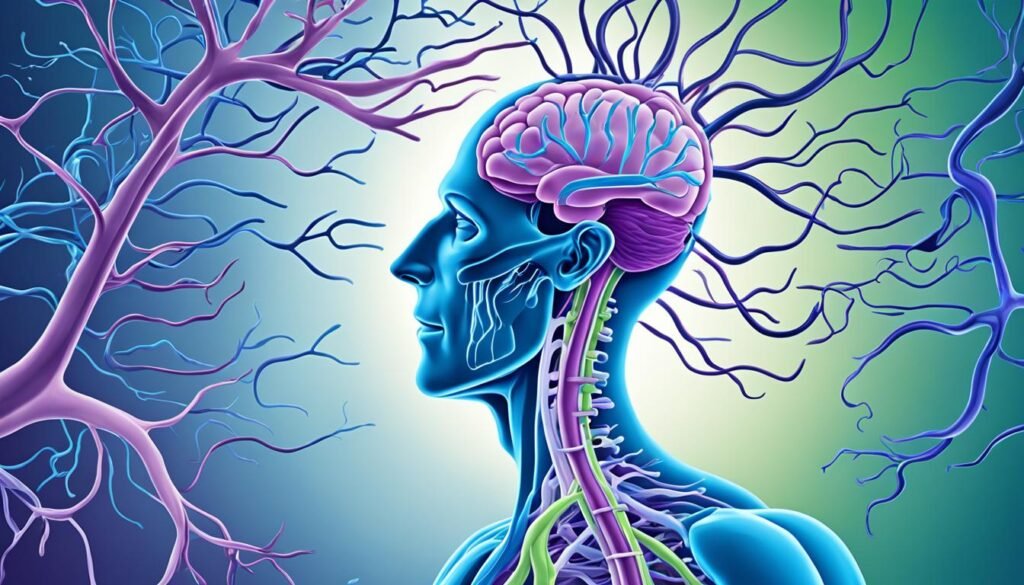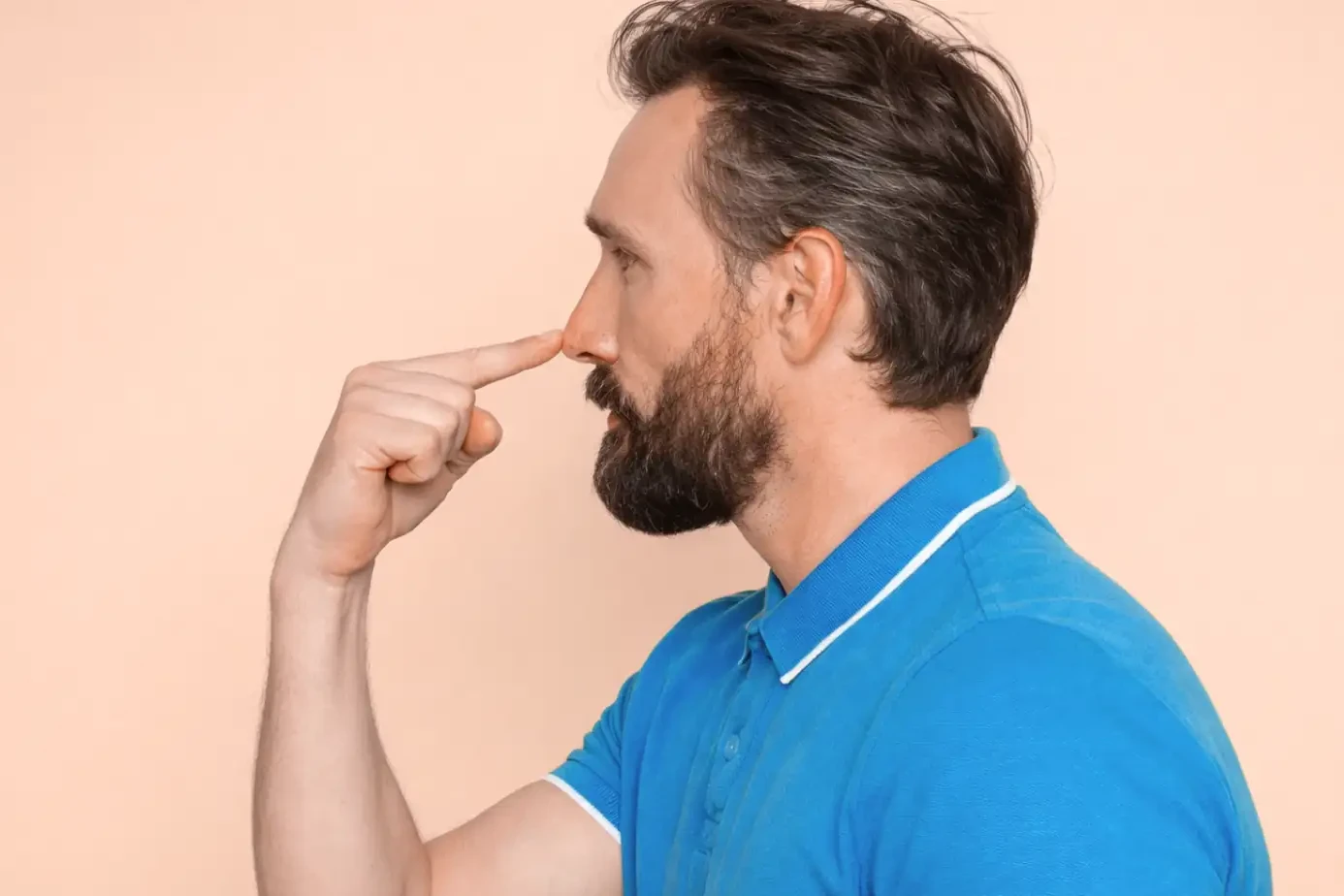Myasthenia gravis is a long-lasting neuromuscular disease. It makes voluntary muscles weaker. This disease happens when the immune system attacks the body’s own cells or proteins by mistake. The start of this issue can happen quickly, and how much the muscle weakness is different in each person.
Symptoms of myasthenia gravis can include weak eye muscles, droopy eyelids, and trouble seeing clearly. You might also have problems with your face, trouble swallowing, and find it hard to breath. Talking might be tough, and you could have weakness in your arms, hands, legs, or neck. This disease affects lots of people, including young adult women and older men from various backgrounds.
Table of Contents
ToggleWhat is Myasthenia Gravis?
Definition and Overview
Myasthenia gravis is a long-term condition that makes your muscles weak. It affects the muscles you control, including those in your face and those needed for breathing. This happens because the immune system attacks these muscles by mistake. The weakness can appear suddenly and can be different from person to person.
Voluntary Muscle Weakness
This disease mainly affects muscles you use by choice. It troubles the muscles in your eyes, face, and arms. People with myasthenia gravis often find walking, talking, or breathing tough because of this weakness.
Autoimmune Disorder
Myasthenia gravis is caused by the body attacking its own nerve-muscle connection. This leads to the weakness and tiredness people with this condition experience.
Symptoms of Myasthenia Gravis
Myasthenia gravis affects voluntary muscles, causing weakness. Symptoms start slowly and can get worse over time. Common signs include:
Eye Muscle Weakness
Over half of its sufferers first notice problems with eye muscles. This can cause drooping eyelids and seeing double. It makes daily tasks harder and blurs vision.
Facial and Throat Muscle Weakness
15% face issues with speaking, swallowing, and facial movements first. This affects talking, eating, and expressions. Difficulty in these areas might be a first sign for some.
Limb and Neck Muscle Weakness
It can weaken neck, arm, and leg muscles. This makes walking and head support hard. Muscle issues get worse with effort and better with rest.
Symptoms often get worse over the first few years. Things like tiredness, stress, or certain drugs can make symptoms worse. When someone is pregnant or during periods, this may also show up more.
Causes of Myasthenia Gravis
Myasthenia gravis happens when nerves and muscles can’t communicate properly at the neuromuscular junction. This occurs because antibodies stop the acetylcholine, a trigger for muscle movement, from working. The main culprit is antibodies against the acetylcholine receptor. However, antibodies to other proteins like MuSK can also cause trouble at these junctions.
Antibody Interference
The main cause of myasthenia gravis is the immune system making the wrong kind of antibodies. These antibodies mess up the proper working of the acetylcholine receptors. This messes with muscle movement.
Role of the Thymus Gland
The thymus gland helps control the immune system. It seems to have a part in causing the body to make these problem antibodies. Issues in the thymus, like thymic hyperplasia or thymomas, are linked to this disease.
Diagnosing Myasthenia Gravis
Diagnosing myasthenia gravis is a detailed process. It involves a physical and neurological exam, electrodiagnostic tests, and blood work. This approach is used to confirm myasthenia gravis and rule out other causes.
Physical and Neurological Examination
Your doctor will look at your medical history and symptoms during the physical exam. They mainly focus on muscle weakness and tiredness. For the neurological exam, they check your muscle strength, how well you can move, and eye function. This helps them pinpoint the problem.
Electrodiagnostic Tests
Tests like repetitive nerve stimulation and single-fiber EMG are done. They check the signals between nerves and muscles. These tests show if your nerves work well with muscles, especially when you’re tired.
Blood Tests
Blood tests look for certain antibodies related to myasthenia gravis. Finding these antibodies helps confirm the disease. But not everyone with myasthenia gravis will have these antibodies, especially if it’s just in the eyes. If your first blood test is clear but you still have symptoms, you might need another test.

Treating Myasthenia Gravis
Myasthenia gravis doesn’t have a cure yet, but there are ways to treat it. These treatments can help with the symptoms and make muscle weakness better. They focus on helping the muscles work and preventing problems with swallowing and breathing.
Anticholinesterase Medications
Meds like mestinon or pyridostigmine are usually the first choice for treating myasthenia gravis. They help by slowing how fast acetylcholine, a key for muscle movement, breaks down. This makes the muscles work better for a while. Yet, the improvement only lasts a few hours, so doses have to be taken several times a day.
Thymectomy
Sometimes, removing the thymus gland can help lessen myasthenia gravis symptoms. This surgery, called a thymectomy, might work in some patients. The thymus appears to be part of why the autoimmune response happens. After the surgery, it may take a few years to see full improvement. But there are newer, less invasive surgeries that are better because they cause less blood loss and make the hospital stays shorter.
Immunosuppressive Drugs
If medicines like anticholinesterase or surgery don’t work, doctors may try immunosuppressive drugs. These include prednisone, azathioprine, and tacrolimus. They help by stopping the body from making harmful antibodies. But they come with side effects like making bones thin and gaining weight.
Plasmapheresis and IVIG
In very serious cases, when symptoms suddenly become very severe, doctors might use plasmapheresis or IVIG. Plasmapheresis cleans the blood to get rid of harmful antibodies. IVIG changes the immune system for a short time. These quick treatments can help a lot, but the relief is not permanent.
Myasthenia Gravis in Children and Infants
Myasthenia gravis rarely affects infants. However, a similar condition, called neonatal myasthenia gravis, can happen. In this, the fetus gets antibodies from the mom. Most times, neonatal myasthenia gravis goes away on its own. The baby’s symptoms vanish within two to three months after birth.
Some children might get congenital myasthenia, not from their parents’ genes. It happens due to mutations in specific genes. This can lead to muscle weakness, breathing trouble, and difficulty eating or swallowing.

Kids with myasthenia gravis show varying symptoms. These can include muscle weakness, breathing problems, and difficulty eating or swallowing. They might also have droopy eyelids or be slow to develop motor skills. Treating myasthenia gravis in children could require breathing and nutrition support. Medications and sometimes a ventilator might be needed too.
Parents need to act if their child’s condition doesn’t get better or gets worse. New symptoms should also prompt a visit to the doctor. Regular check-ups are important. They help monitor the child’s health and adjust treatment when necessary.
Complications of Myasthenia Gravis
Myasthenia gravis can be controlled with the right treatment. However, it can lead to serious issues. The
Myasthenic crisis
This is a major concern. It brings extreme muscle weakness that affects the chest and diaphragm muscles.
This can make breathing hard and shallow. A crisis might happen if you don’t take your medicine, have a respiratory infection, are very stressed, or after surgery. In extreme cases, someone might need a machine to help them breathe until their muscles get stronger again. Fast medical help is very important because a myasthenic crisis can be deadly.
Also, people with myasthenia gravis might have
Thymus gland tumors, known as thymomas. These are often not cancerous, but they can sometimes turn into cancer. People with myasthenia gravis have a greater chance of getting these thymus tumors. Surgery or other treatments might be needed.
Regular check-ups and managing myasthenia gravis complications are key. This helps make sure those with the condition get the best outcomes possible.
Lifestyle and Management
Myasthenia gravis has no cure, but its symptoms can be managed. Treatment focuses on improving muscle function. This helps avoid problems with swallowing and breathing. With proper care, many people with myasthenia gravis can live almost as they did before.
Exercise and Activity
For some, gentle exercising can be good. It’s crucial to strike a balance between being active and getting enough rest. The right food, sleep, and keeping stress low are vital for managing this condition.
Assistive Devices
Assistive devices are helpful for managing myasthenia gravis. They can be anything from aids for moving around, tools for communication, to special equipment for everyday tasks.

Latest Research Updates
Scientists keep learning more about myasthenia gravis and its roots. They now know a lot about the links between nerves and muscles. Thanks to new tech, they can diagnose it better and faster. This has led to new treatments that improve patients’ lives.
The National Institutes of Health (NIH) and its branch, the National Institute of Neurological Disorders and Stroke (NINDS), support a lot of this research. They’re working on ways to diagnose, treat, and maybe even prevent myasthenia gravis. One cool thing they’re looking into is gene therapy for certain types of the disease.
About 15-20% of myasthenia gravis patients might have a myasthenic crisis at some point. But, up to half of them won’t know what caused it. Now, the FDA says a drug called eculizumab can help. It’s for adults with the form of the disease that shows a certain antibody.
In some rare cases, people with myasthenia gravis don’t have the usual antibodies. This is called seronegative myasthenia. For these patients, if they have surgery to remove their thymus gland, a full recovery might be possible. This surgery can help about half of the people who have it.
Studies are still going on to make things better for myasthenia gravis patients. Special medicines like rituximab and inebilizumab look very promising. They have made patients’ lives much better. As we learn more, our hope is to find even better ways to help people with myasthenia gravis.
What is Myasthenia Gravis? An Overview
Myasthenia gravis is a long-term autoimmune disorder. It makes antibodies attack the link between nerves and muscles. This leads to weakness in the voluntary muscles. These include those for moving the eyes, mouth, throat, and limbs.
It’s more common in young women (age 20 and 30) and men aged 50 and older. A myasthenia gravis overview shows it can cause trouble swallowing or breathing. While it has no cure, managing it early can help people lead better and longer lives.
A myasthenia gravis definition points out that it’s an autoimmune disorder. It creates weakness in the voluntary muscles by attacking the receptors that connect nerves and muscles. This interrupts the muscle control signals from the nerves.

The effects of myasthenia gravis can vary a lot. Some feel the symptoms mainly in their eyes, face, and throat. Others also have weakness in their limbs and neck.
In any case, a myasthenia gravis crisis is a serious situation. It might need immediate medical help and sometimes a breathing machine.
Risk Factors and Demographics
Myasthenia gravis is not passed down or spread from someone to another. It often shows up later in life. This happens when the body’s own antibodies start attacking the normal muscle receptors. This breaks the signals needed for muscles to move as they should.
Young women between 20 and 30 and older men over 50 might face this disease more. But, it’s possible at any age, even in children. The risk factors for myasthenia gravis aren’t clear. It can affect anyone, regardless of their age or gender.
Doctors are still not sure why the disease seems to pick certain ages and genders more often. They think hormones and immune system reactions might be a part of it. Studies are going on to understand this autoimmune illness better.
Conclusion
Myasthenia gravis is a chronic autoimmune disorder. It causes weakness in your body’s voluntary muscles. Sadly, there’s no cure for it. But, catching it early and managing it well can help people live better lives.
Treatments focus on improving muscle function. They also try to stop problems with swallowing and breathing. This is done using medicines, surgery, and therapies. These help fix issues with the immune system’s functioning.
Ongoing research helps us understand and treat this condition better. The National Institutes of Health (NIH), through the National Institute of Neurological Disorders and Stroke (NINDS), leads this effort. They’re working on better ways to diagnose, treat, and even prevent myasthenia gravis. This includes creating targeted gene therapies for some types.
Thanks to this ongoing work, people living with myasthenia gravis can hope for a better life. They may find it easier to manage their condition in the long term. This offers real hope for a brighter future.
FAQ
What is myasthenia gravis?
Myasthenia gravis is a long-lasting disease that weakens muscles we control. It happens because the body’s defense system attacks itself. This mistake harms normal body functions.
What are the common symptoms of myasthenia gravis?
Signs of myasthenia gravis include weak eye muscles and sagging eyelids. People may see double or blurry. Faces may look different. Swallowing food can be hard. Breathing might become more difficult. Talking and moving arms, legs, and neck can be weakened.
What causes myasthenia gravis?
Myasthenia gravis starts with nerve signals to the muscles being wrongly sent. This usually occurs at the place where nerves and muscles meet. Antibodies then block important muscle receptors. These are for acetylcholine, a key neurotransmitter for muscle movements.
How is myasthenia gravis diagnosed?
Doctors diagnose myasthenia gravis with physical exams, nerve tests, and blood work. These tests find issues with nerve-to-muscle communication. They also look for special antibodies linked to the disease.
What treatments are available for myasthenia gravis?
Although there is no cure for myasthenia gravis, treatments can improve muscle weakness. These include various medications, surgery to remove the thymus gland, and drugs that lessen the immune system reaction. Other options are plasmapheresis and immunoglobulin given through a vein.
Can myasthenia gravis affect children and infants?
Myasthenia gravis is rare in infants, but neonatal myasthenia may happen when a fetus gets antibodies from the mother. In very few cases, even children with healthy parents can develop a form called congenital myasthenia. This type is due to gene mutations, not an immune reaction.
What are the potential complications of myasthenia gravis?
A big concern with myasthenia gravis is myasthenic crisis. This is when muscles, including those for breathing, get very weak. It can be life-threatening. Some with this disease might develop thymomas, which are tumors in the thymus gland. These can turn into cancer.
How can people with myasthenia gravis manage their condition?
Managing myasthenia gravis involves treatment, light exercise, and the use of support devices. Eating well, sleeping enough, and handling stress are also important. With these, many can live close to a normal life.
What is the latest research on myasthenia gravis?
Researchers are still learning a lot about myasthenia gravis. They focus on its causes and ways to fight it. Agencies like the NIH support studies to improve care and find new treatments. This includes work on gene therapy for the disease.
Source Links
- https://www.mayoclinic.org/diseases-conditions/myasthenia-gravis/symptoms-causes/syc-20352036
- https://www.hopkinsmedicine.org/health/conditions-and-diseases/myasthenia-gravis
- https://www.ninds.nih.gov/health-information/disorders/myasthenia-gravis
- https://www.nhs.uk/conditions/myasthenia-gravis/
- https://my.clevelandclinic.org/health/diseases/17252-myasthenia-gravis-mg
- https://www.mayoclinic.org/diseases-conditions/myasthenia-gravis/diagnosis-treatment/drc-20352040
- https://www.nhs.uk/conditions/myasthenia-gravis/diagnosis/
- https://www.nhs.uk/conditions/myasthenia-gravis/treatment/
- https://www.stanfordchildrens.org/en/topic/default?id=myasthenia-gravis-mg-in-children-90-P02612
- https://www.ncbi.nlm.nih.gov/books/NBK558935/
- https://www.chop.edu/conditions-diseases/myasthenia-gravis
- https://www.myasthenia.au/patient-support/lifestyle/
- https://www.ncbi.nlm.nih.gov/pmc/articles/PMC10407383/
- https://bmjmedicine.bmj.com/content/2/1/e000241
- https://www.ncbi.nlm.nih.gov/books/NBK559331/
- https://www.ncbi.nlm.nih.gov/pmc/articles/PMC7982252/
- https://www.ncbi.nlm.nih.gov/pmc/articles/PMC3721240/
- https://myasthenia.org/Understanding-MG/Overview-of-MG
- https://link.springer.com/article/10.1007/s00415-016-8045-z
About The Author

This article is medically reviewed by Dr. Chandril Chugh, Board-Certified Neurologist, providing expert insights and reliable health information.
Dr. Chandril Chugh is a U.S.-trained neurologist with over a decade of experience. Known for his compassionate care, he specializes in treating neurological conditions such as migraines, epilepsy, and Parkinson’s disease. Dr. Chugh is highly regarded for his patient-centered approach and dedication to providing personalized care.
→ Book a consultation to discover which remedies suit your needs best.




